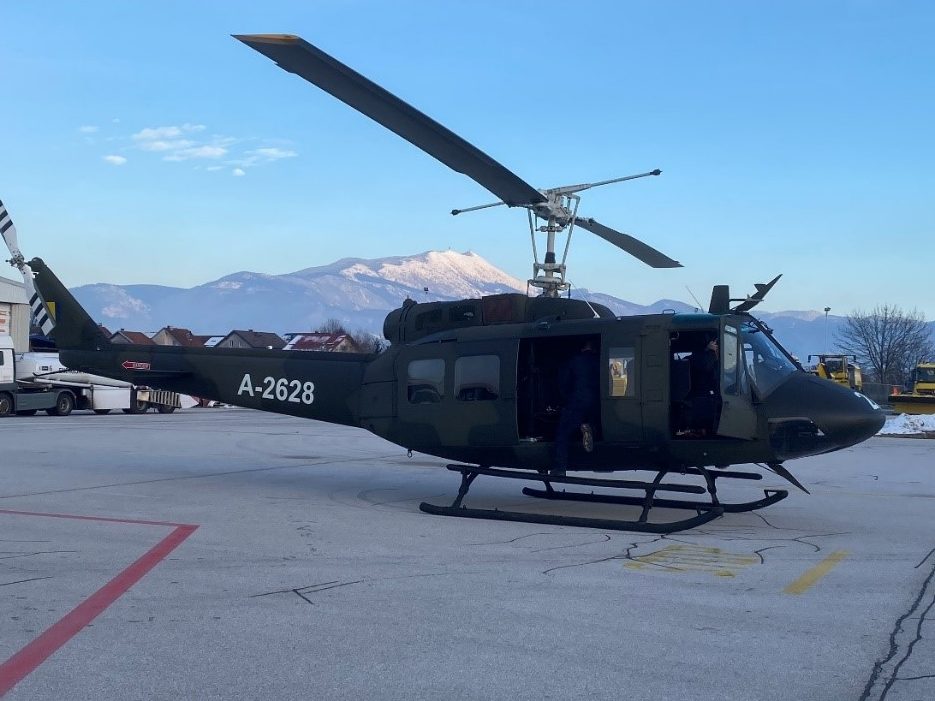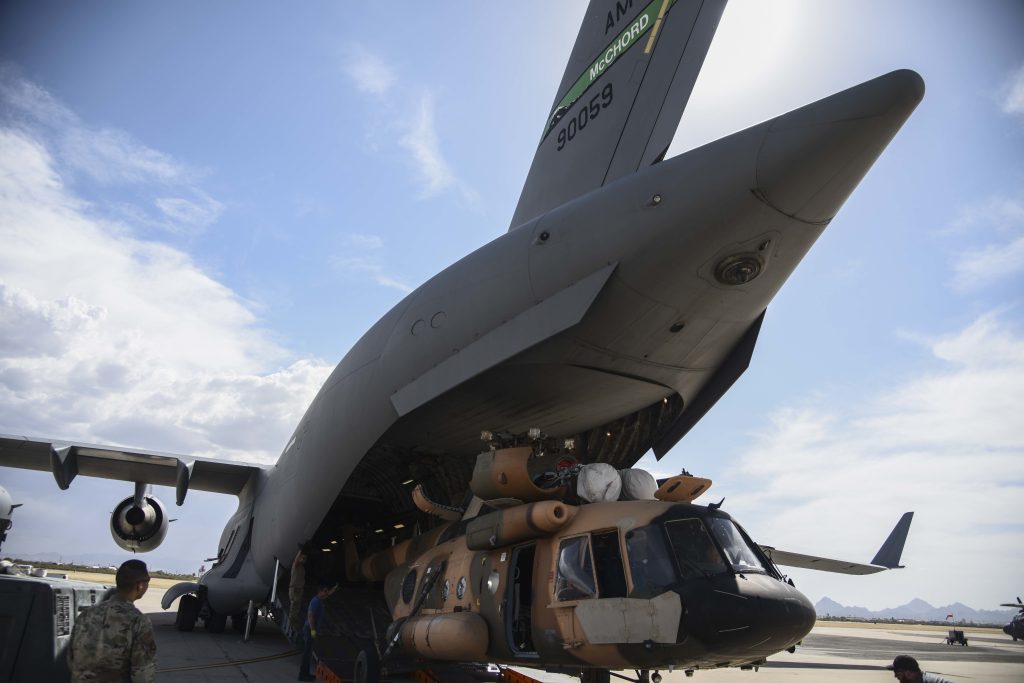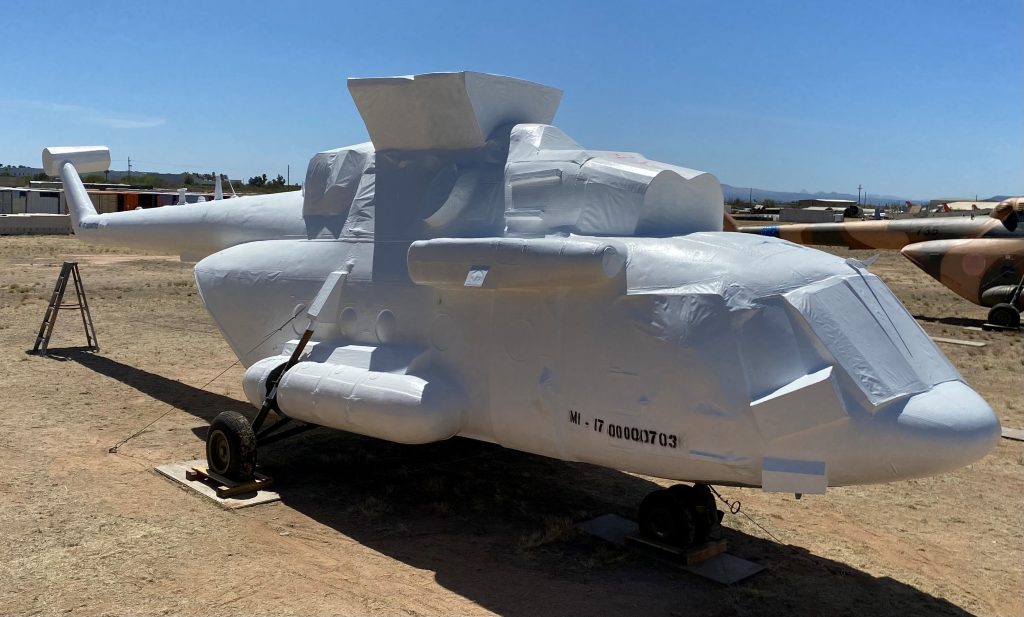
LOADED FOR LEBANON: MD-530FF Advanced Precision Kill Weapons System aircraft loaded inside a Boeing 747 bound for Beirut, Lebanon, in November 2021. By providing these assets and capabilities, the U.S. builds partnership capacity and solidifies allies around the world. (Photo courtesy of MASPO)
MASPO provides cost-effective, highly efficient and affordable aviation capabilities that meet allied and combatant command priorities and build international partnerships in the process.
by Wayne Hudry, Ph.D. and Andy Greer
Equipping, modernizing and empowering allied and partner nations with rotary wing capabilities is a vital U.S. Army security assistance mission. When U.S. allies and partners manage their own internal and external threats, it reduces the risk to our warfighters and frees up U.S. forces for operations elsewhere. Furthermore, allies outfitted with aviation capabilities support the U.S. in achieving operational and tactical agility and help set the conditions for the arrival of U.S. forces in the event it becomes necessary by facilitating access to remote or otherwise denied areas.
Building and supporting our allies’ capabilities serve as a significant deterrent to conflict. When allies are trained and equipped with affordable, U.S.-endorsed aviation assets, our partners can respond to any threat or crisis immediately. The addition of reliable and robust rotary wing assets provides U.S. partner nations the capability to conduct humanitarian assistance, disaster relief, counterterrorism, counterinsurgency, stability and other military operations.
Many of America’s allies and partners, such as Kenya, Greece and Bosnia and Herzegovina, have combatant command-endorsed rotary wing requirements, yet they cannot use U.S. standard Blackhawk (UH-60), Apache (AH-64), Chinook (CH-47) and Future Vertical Lift platforms because of economic realities. Responding to these realities, DOD created a small project management office, under the umbrella of the Army’s Program Executive Office for Aviation, to provide cost-efficient, non-program of record rotary wing aircraft to our partners and allies.
In 2010, the undersecretary of defense for acquisition, technology and logistics issued an acquisition decision memorandum designating the Army as the lead service for DOD acquisition of Mi-17 and any other “non-standard rotary wing aircraft.” From this memorandum the Non-Standard Rotary Wing Aircraft Project Management Office was formed and later became the Multi-National Aviation Special Project Office, known as MASPO.
MASPO’s mission is clear: Develop, deliver and support non-standard rotary wing aircraft for DOD and allied countries, or as directed by the Office of the Secretary of Defense in support of overseas contingency operations. The MASPO mission elevates the warfighting capabilities of our nation’s allies and improves international relations with each country supported.

BOSNIA DELIVERED: A Huey II helicopter sits on the ground after MASPO delivered four to Bosnia and Herzegovina in December 2021. (Photo courtesy of MASPO)
A UNIQUE MISSION
This unique mission includes providing total package helicopter acquisition, sustainment and support on an international scale. MASPO sets the standard for aircraft maintenance, modifications, overhauls, full life cycle systems management and assures the enhanced safety and airworthiness for the multiple aircraft types operated by our allies.
“This team is a juggernaut,” said Col. Tim McDonald, the MASPO project lead. “Once they receive a mission, they are innovative and unstoppable in getting the capabilities to where they are needed.”
Initially created to procure, sustain and support Mi-17 helicopters for operations in Afghanistan, MASPO’s mission has steadily evolved to include 16 different types of aircraft supporting 29 countries around the globe. To meet the needs of our partners, the aircraft portfolio expanded to include AH-6, UH-1, AW-139, Bell 407, Bell 412, AH-1 Cobra, OH-58 A/C/D, AW-119 and MD-530F aircraft. MASPO’s global portfolio is nearly 400 aircraft, as foreign military sales programs grow to meet the increasing demand for U.S.-endorsed rotary wing capabilities.

FROM THE U.S. TO GREECE: OH-58 Kiowa helicopters are craned out of the hull of a ship at Port Volos, Greece, in May 2019, part of a MASPO delivery building partnership capacity. (Photo courtesy of MASPO)
CAREFUL COORDINATION, SAFE RETURN AND UNPRECEDENTED FLEXIBILITY
One of MASPO’s signature accomplishments is the thoroughness with which the project office conducted its original mission throughout the past decade. The MASPO team demonstrated flexibility in the support of aviation combat operations in Afghanistan from the building and supporting of Afghan combat power to the drawdown of troops and retrograde operations. Over a 10-year period, MASPO delivered more than 200 aircraft to Afghanistan and provided more than 400 personnel who performed daily maintenance and kept the aircraft flying in the combat theater.
As NATO forces began withdrawal from Afghanistan, MASPO’s mission continued as the Afghan government still needed aviation support. MASPO conceptualized and implemented a comprehensive, multiphase over-the-horizon (OTH) sustainment approach for the Afghan rotary wing fleet. MASPO established three separate OTH sites outside of Afghanistan and out of harm’s way to ensure the aircraft were maintained to standard and the workforce was safe. Upon completion of routine maintenance, heavy repairs and overhauls, the aircraft were returned to Afghanistan to support combat operations.
As the withdrawal from Afghanistan accelerated, MASPO ensured that all sustainment personnel were safely evacuated. Despite the chaos and confusion that resulted from the fall of the government of the Islamic Republic of Afghanistan, MASPO deployed personnel and coordinated the retrieval of multiple aircraft and in excess of 500 tons of aviation repair parts, special tools and ground-support equipment. Working with Transportation Command, MASPO coordinated airlift, rail-haul, line-haul and sealift transportation to the United States. The team literally employed “planes, trains, automobiles and ships” to bring these warfighting assets back home and staged them for future use by the United States or our allies. The team also maintained accountability of 10 aircraft going through combat-related repairs and overhauls in three separate Eastern European countries. MASPO was an essential player in the whole-of-government approach to properly disposition the aircraft and equipment while providing stewardship for U.S. taxpayer funds.
With the aircraft safely back in U.S. possession, they became available to support our allies and other governmental agencies. When the White House released a presidential directive that included rotary wing assets in support of Ukraine, MASPO once again rose to the challenge, working with the Department of the Army to provide insight and support in delivering the recovered helicopters, parts and tools to our Ukrainian allies to combat Russian aggression. Through MASPO’s relentless efforts, those aircraft are now involved in combat operations in Ukraine.

ON TO UKRAINE: An Mi-17 helicopter is loaded on to a C-17 Globemaster III aircraft at Davis-Monthan Air Force Base, Arizona, on June 9. The aircraft was pulled from storage at the Aerospace Maintenance and Regeneration Group there and air-transported to Slovakia to be picked up by Ukraine. MASPO has facilitated the delivery of a total of 18 aircraft in support of Ukraine. (Photo by Airman 1st Class William Turnbull, U.S. Air Force)
FROM CONCEPT TO COMBAT-CAPABLE IN RECORD TIME
Another one of MASPO’s building partner capacity success stories took place in Lebanon. In the fall of 2021, the team delivered six highly modified MD-530F helicopters to the Lebanese Armed Forces Air Force. The fielding marked the final milestone of a $100 million effort to develop and integrate the Advanced Precision Kill Weapon System onto the commercial MD-530 platform. This resulted in a new light attack platform with guided-rocket capability. The Advanced Precision Kill Weapon System is a federated network consisting of a weapons management system, multifunction displays, electro-optical and infrared sensors and guided rockets, all assimilated into a glass cockpit.
While the system was being developed, tested and integrated into the MD-530 cockpit by Redstone Arsenal’s Prototype Integration Facility, MASPO optimized time by concurrently facilitating pilot qualification training, aircraft maintenance training and armament technician training to arm, maintain and operate the advanced weapon system. With trained aircrew members and an airworthy platform, MASPO arranged a successful live-fire event at Yuma Proving Ground, Arizona, to prove the competency of the crews and to validate the combat effectiveness of the enhanced aircraft. While the standard appropriated funds for acquisition cycle can take eight to 12 years, MASPO accomplished the task from concept to combat-capable within three years.
In 2023, MASPO is committed to expanding global aviation reach by initiating and growing strategic alliances and increasing allied speed to combat operations. Sixteen aircraft are already scheduled for delivery to international partner countries worldwide. MASPO remains ready to support countries that want to expand their warfighting capabilities by offering affordable rotary wing options backed by the United States.

WAITING FOR THE NEXT MISSION: An Mi-17 aircraft is sealed for storage at the Aerospace Maintenance and Regeneration Group at Davis-Monthan Air Force Base, Arizona, in December 2021. MASPO, working with the Defense Security Cooperation Management Office ‒ Afghanistan, choreographed the retrieval of 30 aircraft, aviation repair parts, special tools and ground support equipment from Afghanistan and coordinated the storage and staging of the recovered aircraft for future use by the United States and allies. (Photo courtesy of MASPO)
CONCLUSION
MASPO serves as an ambassador for the United States by developing, delivering and supporting non-program of record rotary wing aircraft, excess defense articles, militarized versions of commercial aircraft or their sustainment worldwide by providing cost-effective, highly capable and affordable aviation capabilities that meet allied and combatant command priorities and build international partnerships in the process. Empowered by the Office of the Secretary of Defense, the secretary of the Army and PEO Aviation, each of MASPO’s aircraft deliveries, hardware modifications and enhancements enables the warfighting capabilities of our international partners and solidifies strategic relationships. Through these strategic interactions, MASPO contributes to the defense of the United States, our allies, and promotes U.S. strategic interests worldwide.
For more information, contact Col. Tim McDonald, timothy.d.mcdonald2.mil@army.mil, 256-313-2515 or Dr. Wayne Hudry, wayne.r.hudry.civ@army.mil, 256-876-7262.
WAYNE R. HUDRY, PH.D. is deputy project lead for the Multi-National Aviation Special Project Office. He holds a Ph.D. in industrial and systems engineering from the University of Alabama in Huntsville, an M.S. in electrical engineering, an M.A. in business and a B.S. from the U.S. Military Academy at West Point. He is a 2014 graduate of the Senior Service College Fellowship.
ANDY GREER is a member of the operations team of the Multi-National Aviation Special Project Office. He attended the Air Force Air Command and Staff College and earned his M.A. in military operational art and science. He was commissioned into the Army as an aviation officer in May 1992 from the University of Alabama, where he earned his B.A. in organizational communication. While in the Army, he commanded at both the company and field grade level including the Army Aviation Officer Basic Course. He retired from active duty in 2017 as a senior Army aviator having earned the Combat Action Badge, the Air Assault Badge and Airborne Badge.







